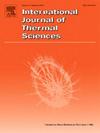The study on calculation method of burning rates of discrete multiple fires
IF 4.9
2区 工程技术
Q1 ENGINEERING, MECHANICAL
International Journal of Thermal Sciences
Pub Date : 2025-06-16
DOI:10.1016/j.ijthermalsci.2025.110053
引用次数: 0
Abstract
A calculation model for dimensionless burning rates in discrete multiple fires is developed based on the quantitative relation between two dominant coupled mechanisms: the radiant heat feedback enhancement and air entrainment restriction. The radiant heat feedback enhancement among discrete fire sources is transferred as external thermal radiation to independent fire source, while the air entrainment restriction is transferred as the decrease in atmospheric pressure for an independent fire source. To reveal their relative dominance, key parameters, dimensionless burning rates , air entrainment restriction coefficient kp,i and separation distance , are introduced. Fitted with the burn-out time data of discrete multiple fire arrays, a formula including these parameters is derived. Based on this formula and the theoretically derived burning rates evolution, the model is proposed, which well-predicts the experimental burning rates. The model effectively predicts burning rate trends under extreme and non-uniform conditions, verifying its feasibility in both actual and theoretical fires. The consistency between uniform and non-uniform arrays suggests that the model can be extended to more complex conditions.
离散多重火灾燃烧速率计算方法的研究
基于辐射热反馈增强和空气吸入限制两种主要耦合机制之间的定量关系,建立了离散多重火灾中无因次燃烧速率的计算模型。离散火源间的辐射热反馈增强以外热辐射的形式传递给独立火源,夹带空气的限制以大气压力的降低的形式传递给独立火源。为了揭示它们的相对优势,引入了无因次燃烧速率m˙i″*、夹带限制系数kp、i和分离距离D−dd等关键参数。拟合离散多火灾阵列的燃尽时间数据,导出了包含这些参数的公式。在此基础上,结合理论推导的燃烧速率演化规律,建立了能较好地预测实验燃烧速率的模型。该模型有效地预测了极端和非均匀条件下的燃速趋势,验证了该模型在实际和理论火灾中的可行性。均匀阵列和非均匀阵列之间的一致性表明,该模型可以推广到更复杂的条件。
本文章由计算机程序翻译,如有差异,请以英文原文为准。
求助全文
约1分钟内获得全文
求助全文
来源期刊

International Journal of Thermal Sciences
工程技术-工程:机械
CiteScore
8.10
自引率
11.10%
发文量
531
审稿时长
55 days
期刊介绍:
The International Journal of Thermal Sciences is a journal devoted to the publication of fundamental studies on the physics of transfer processes in general, with an emphasis on thermal aspects and also applied research on various processes, energy systems and the environment. Articles are published in English and French, and are subject to peer review.
The fundamental subjects considered within the scope of the journal are:
* Heat and relevant mass transfer at all scales (nano, micro and macro) and in all types of material (heterogeneous, composites, biological,...) and fluid flow
* Forced, natural or mixed convection in reactive or non-reactive media
* Single or multi–phase fluid flow with or without phase change
* Near–and far–field radiative heat transfer
* Combined modes of heat transfer in complex systems (for example, plasmas, biological, geological,...)
* Multiscale modelling
The applied research topics include:
* Heat exchangers, heat pipes, cooling processes
* Transport phenomena taking place in industrial processes (chemical, food and agricultural, metallurgical, space and aeronautical, automobile industries)
* Nano–and micro–technology for energy, space, biosystems and devices
* Heat transport analysis in advanced systems
* Impact of energy–related processes on environment, and emerging energy systems
The study of thermophysical properties of materials and fluids, thermal measurement techniques, inverse methods, and the developments of experimental methods are within the scope of the International Journal of Thermal Sciences which also covers the modelling, and numerical methods applied to thermal transfer.
 求助内容:
求助内容: 应助结果提醒方式:
应助结果提醒方式:


